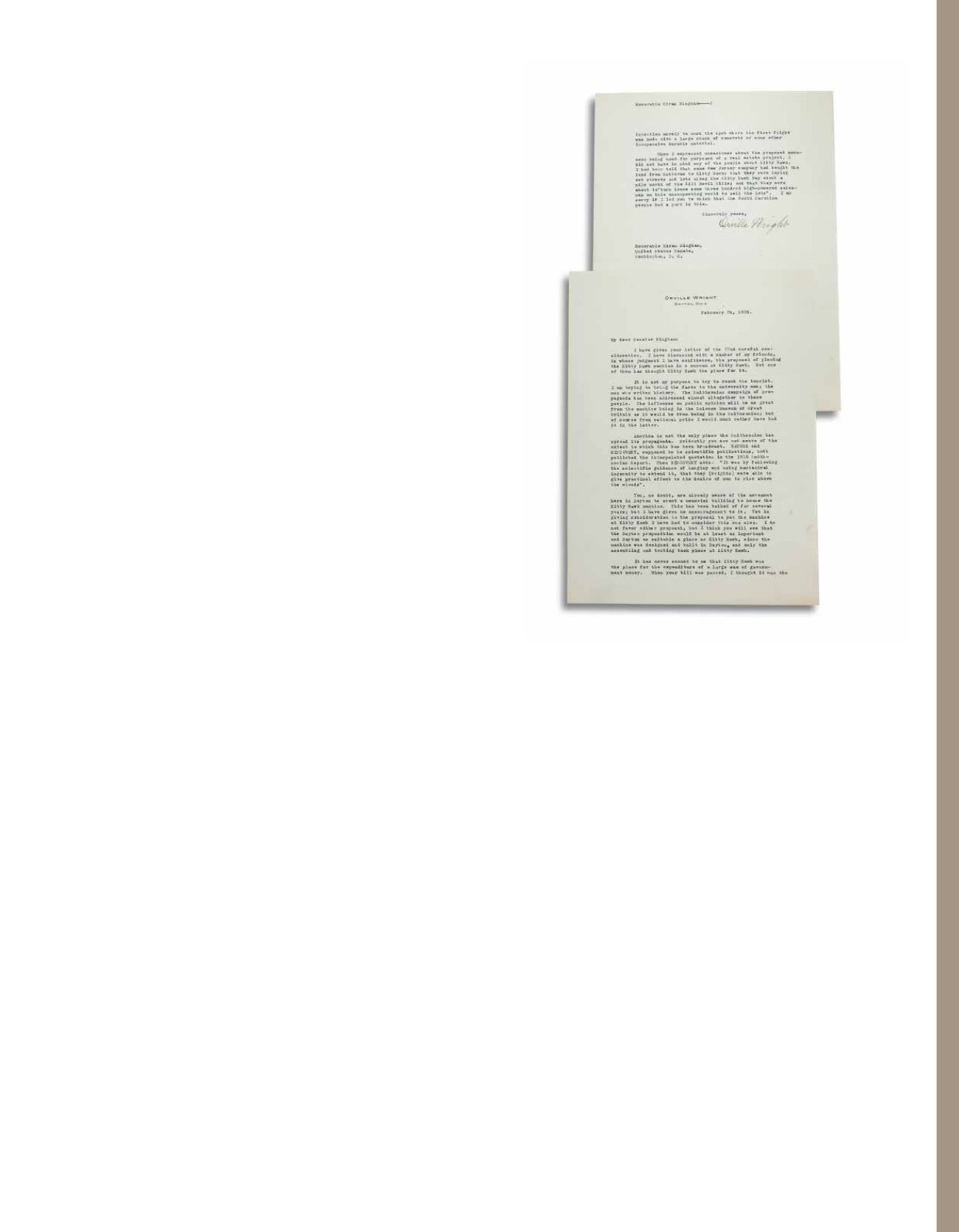

241
britannica - americana
197
WRIGHT ORVILLE
(1871-1948). Aviateur américain.
L.S. « Orville Wright »,
Dayton, Ohio
28 février 1928,
au Sénateur Hiram BINGHAM III, à Washington ; 1 page
et demie in-4 dactylographiées, à son en-tête ; en anglais.
3 000 / 4 000 €
Sur un projet de musée commémoratif du premier vol en 1903
à Kitty Hawk.
[Le sénateur BINGHAM était l’auteur du projet du Congrès américain
de construire un mémorial aux frères Wright à Kitty Hawk (Caroline
du Nord) pour commémorer le 25
e
anniversaire de leur premier vol.
Quelques semaines plus tôt, Wright avait envoyé au Science Museum
de Londres l’aéroplane historique du vol de 1903. Il en profite pour
rappeler que la « propagande » du Smithsonian Institute en faveur
de leur rival Samuel LANGLEY a lésé durablement les frères Wright.]
Wright a bien réfléchi à la proposition de placer la machine Kitty
Hawk dans un musée à Kitty Hawk, il en a parlé avec des amis en
qui il a confiance, et aucun ne croit que ce soit le bon endroit. Le
but de Wright n’est pas d’attirer le touriste. Il voudrait soumettre les
faits à l’universitaire, à l’historien. La campagne de propagande du
Smithsonian a été presque entièrement dirigée vers ceux-là. L’influence
de la machine sur l’opinion publique sera tout aussi grande si elle
est mise dans le Science Museum de Grande Bretagne, que dans le
Smithsonian ; mais naturellement, par orgueil national il aurait préféré
que ce fût dans ce dernier.
L’Amérique n’est pas le seul endroit où le Smithsonian a diffusé
sa propagande. Le sénateur ne semble pas se rendre compte de
l’étendue de cette diffusion.
Nature
et
Discovery
, censés être des
publications scientifiques, ont tous les deux publié la citation interpolée
du
Smithsonian Report
de 1910.
Discovery
a ajouté que c’était sous la
direction scientifique de LANGLEY, avec de l’ingéniosité mécanique,
que les frères Wright purent réaliser le désir de l’homme de s’élever
au-dessus des nuages.
Wright n’a point encouragé le mouvement en vue d’ériger à Dayton
un mémorial pour abriter la machine de Kitty Hawk, mais Dayton
serait au moins aussi approprié que Kitty Hawk, puisque la machine
fut dessinée et construite à Dayton, et que seul l’assemblage et les
essais eurent lieu à Kitty Hawk. Il exprime aussi des doutes quant au
projet coûteux du sénateur, pour un mémorial à Kitty Hawk élevé avec
les deniers publics, et encore plus quant à la spéculation immobilière
dans les environs, dont il a entendu parler...
WRIGHT ORVILLE
(1871-1948). American aviation pioneer.
Signed letter, signed « Orville Wright »,
Dayton, Ohio
28 February 1928, to Senator Hiram BINGHAM III,
in Washington D.C.; 1 page and a half, in-4 format,
typed letter, on his name-imprinted letterhead; in English.
3 000 / 4 000 €
Letter concerning the projective commemorative museum dedicated
to the first 1903 flight from Kitty Hawk and the exhibition of the first
flyer, the “Kitty Hawk machine”.
Senator BINGHAM was the political mastermind behind the project
presented before Congress to build a memorial for the Wright
brothers at Kitty Hawk (North Carolina) to mark the 25
th
anniversary
of their first flight. A few weeks earlier, Wright had sent the historical
aircraft “First Flyer” of the 1903 flight for display at the Science
Museum in London where it remained until the Second World War.
Wright seizes the occasion in this letter to remind the Senator that the
Smithsonian’s “propaganda” in favour of their rival Samuel LANGLEY
did much to discredit the Wright Brothers’ reputation.
“I have given your letter of the 22nd careful consideration. I have
discussed with a number of my friends, in whose judgement I have
confidence, the proposal of placing the Kitty Hawk machine in a
museum at Kitty Hawk. Not one of them has thought Kitty Hawk the
place for it. It is not my purpose to try to reach the tourist. I am trying
to bring the facts to the university man; the man who writes history.
The Smithsonian campaign of propaganda has been addressed almost
altogether to these people. The influence on public opinion will be
as great from the machine be it in the Science Museum of Great
Britain as it would be from being in the Smithsonian; but of course
from national pride I would much rather have had it in the latter."
“America is not the only place the Smithsonian has spread its
propaganda. Evidently you are not aware of the extent to which
this has been broadcast. NATURE and DISCOVERY, supposed to
be scientific publications, both published the interpolated quotation
in the 1910 Smithsonian Report. Then DISCOVERY adds: ‘It was by
following the scientific guidance of Langley and using mechanical
ingenuity to extend it, that they (Wrights) were able to give practical
effect to the desire of man to rise above the clouds’. You, no doubt, are
already aware of the movement here in Dayton to erect a memorial
building to house the Kitty Hawk machine. This has been talked of for
several years; but I have given no encouragement to it. Yet in giving
consideration to the proposal to put the machine at Kitty Hawk I have
had to consider this one also. I do not favor either proposal, but I
think you will see that the Dayton proposition would be at least as
important and Dayton as suitable a place as Kitty Hawk, since the
machine was designed and built in Dayton, and only the assembling
and testing took place at Kitty Hawk…”
















